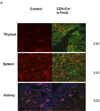The role of type 1 angiotensin receptors on T lymphocytes in cardiovascular and renal diseases
- PMID: 23160867
- PMCID: PMC3545101
- DOI: 10.1007/s11906-012-0318-z
The role of type 1 angiotensin receptors on T lymphocytes in cardiovascular and renal diseases
Abstract
The renin-angiotensin system plays a critical role in the pathogenesis of several cardiovascular diseases, largely through activation of type I angiotensin (AT(1)) receptors by angiotensin II. Treatment with AT(1) receptor blockers (ARBs) is a proven successful intervention for hypertension and progressive heart and kidney disease. However, the divergent actions of AT(1) receptors on individual cell lineages in hypertension may present novel opportunities to optimize the therapeutic benefits of ARBs. For example, T lymphocytes make important contributions to the induction and progression of various cardiovascular diseases, but new experiments indicate that activation of AT(1) receptors on T cells paradoxically limits inflammation and target organ damage in hypertension. Future studies should illustrate how these discrepant functions of AT(1) receptors in target organs versus mononuclear cells can be exploited for the benefit of patients with recalcitrant hypertension and other cardiovascular diseases.
Conflict of interest statement
Figures


Similar articles
-
Advantages of renin-angiotensin system blockade in the treatment of cardiovascular diseases.Med Arh. 2010;64(5):295-9. Med Arh. 2010. PMID: 21287956 Review.
-
The vasoprotective axes of the renin-angiotensin system: Physiological relevance and therapeutic implications in cardiovascular, hypertensive and kidney diseases.Pharmacol Res. 2017 Nov;125(Pt A):21-38. doi: 10.1016/j.phrs.2017.06.005. Epub 2017 Jun 12. Pharmacol Res. 2017. PMID: 28619367 Free PMC article. Review.
-
Theoretical basis and clinical evidence for differential effects of angiotensin-converting enzyme inhibitors and angiotensin II receptor subtype 1 blockers.Curr Opin Nephrol Hypertens. 2000 Jul;9(4):403-11. doi: 10.1097/00041552-200007000-00012. Curr Opin Nephrol Hypertens. 2000. PMID: 10926177 Review.
-
Current strategies to achieve further cardiac and renal protection through enhanced renin-angiotensin-aldosterone system inhibition.Rev Recent Clin Trials. 2011 May;6(2):134-46. doi: 10.2174/157488711795177912. Rev Recent Clin Trials. 2011. PMID: 21241234 Review.
-
The pathophysiology of hypertension: the importance of angiotensin II in cardiovascular remodeling.Am J Hypertens. 1998 Nov;11(11 Pt 2):177S-181S. doi: 10.1016/s0895-7061(98)00198-8. Am J Hypertens. 1998. PMID: 9833876 Review.
Cited by
-
Dipeptidyl peptidase inhibition prevents diastolic dysfunction and reduces myocardial fibrosis in a mouse model of Western diet induced obesity.Metabolism. 2014 Aug;63(8):1000-11. doi: 10.1016/j.metabol.2014.04.002. Epub 2014 Apr 12. Metabolism. 2014. PMID: 24933400 Free PMC article.
-
Novel Immune Mechanisms in Hypertension and Cardiovascular Risk.Curr Cardiovasc Risk Rep. 2017;11(4):12. doi: 10.1007/s12170-017-0537-6. Epub 2017 Mar 6. Curr Cardiovasc Risk Rep. 2017. PMID: 28360962 Free PMC article. Review.
-
Reconstruction Set Test (RESET): a computationally efficient method for single sample gene set testing based on randomized reduced rank reconstruction error.bioRxiv [Preprint]. 2023 Apr 20:2023.04.03.535366. doi: 10.1101/2023.04.03.535366. bioRxiv. 2023. Update in: PLoS Comput Biol. 2024 Apr 29;20(4):e1012084. doi: 10.1371/journal.pcbi.1012084. PMID: 37066315 Free PMC article. Updated. Preprint.
-
The immune system and hypertension.Immunol Res. 2014 Aug;59(1-3):243-53. doi: 10.1007/s12026-014-8548-6. Immunol Res. 2014. PMID: 24847766 Free PMC article. Review.
-
Pericardial adipose tissue promotes transition to heart failure with reduced ejection fraction upon pressure-overload in mice.Basic Res Cardiol. 2025 Jul 3. doi: 10.1007/s00395-025-01116-x. Online ahead of print. Basic Res Cardiol. 2025. PMID: 40610731
References
-
- Probstfield JL, O'Brien KD. Progression of cardiovascular damage: the role of reninangiotensin system blockade. Am J Cardiol. 2010;105:10A–20A. - PubMed
-
- Mehta PK, Griendling KK. Angiotensin II cell signaling: physiological and pathological effects in the cardiovascular system. Am J Physiol Cell Physiol. 2007;292:C82–C97. - PubMed
-
- Crowley SD, Tharaux PL, Audoly LP, et al. Exploring type I angiotensin (AT1) receptor functions through gene targeting. Acta Physiol Scand. 2004;181:561–570. - PubMed
-
- Yusuf S, Teo KK, Pogue J, et al. Telmisartan, ramipril, or both in patients at high risk for vascular events. N Engl J Med. 2008;358:1547–1559. - PubMed
-
- Mann JF, Schmieder RE, McQueen M, et al. Renal outcomes with telmisartan, ramipril, or both, in people at high vascular risk (the ONTARGET study): a multicentre, randomised, double-blind, controlled trial. Lancet. 2008;372:547–553. - PubMed
Publication types
MeSH terms
Substances
Grants and funding
LinkOut - more resources
Full Text Sources
Medical
Research Materials

